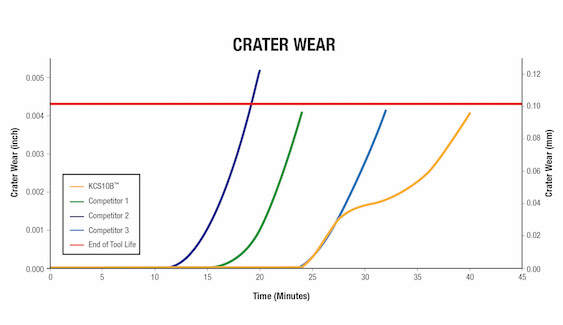High-Temperature Applications Don’t Faze This Insert
Armed with a special coating and proprietary sputtering technology, Kennametal’s KCS10B overcomes the most common challenges of machining superalloys — cratering and depth-of-cut notching — that often cause unexpected and even catastrophic tool failure.
Posted: August 26, 2020
Featuring a revolutionary coating applied to an ultrafine-grain carbide substrate for superior layer adhesion, the KCS10B from Kennametal Inc. (Pittsburgh, PA) delivers up to 50% greater tool life, more predictable processes, and improved productivity when working with difficult-to-machine nickel, cobalt, and iron-based superalloys used in aerospace and other high-temperature applications. The insert overcomes the most common challenges encountered in turning superalloys — cratering and depth-of-cut (DOC) notching — two wear modes that often lead to unexpected and even catastrophic tool failure.
Rather than the light rain of droplets that fall on cutting tools during traditional PVD coating processes, Kennametal´s proprietary high-power impulse magnetron sputtering (High-PIMS) technology generates a fine mist of AlTiN, building a series of extremely thin, smooth, and wear-resistant layers. In addition to a smoother surface, the coating process produces a much sharper edge.
Metals such as Inconel 718 and Stellite 31 are notorious for causing rapid wear and unpredictable tool life. KCS10B is proven to reduce DOC notching and extend tool life from 3 minutes to upwards of 5 minutes in roughing operations. Tool life in finishing operations fares even better, with visible cratering and tool failure often delayed by a factor of two or three compared to competitive brands.
“Our advanced honing and edge-preparation process reduces the friction that leads to heat, which further improves tool life,” says Senior Global Product Manager for Turning Robert Keilmann. “It also means less built-up edge, another common failure mode in superalloys. When coupled with our inserts’ excellent dimensional accuracy, shops can expect the increased performance, stability, and predictability needed to be successful with challenging alloys.”
Positive and negative rake inserts are available, as well as various chip formers, edge preparations, and geometries, making KCS10B the ideal solution when turning iron-based (S1), cobalt-based (S2), or nickel-based (S3) alloys.
















